- Notice
- over the counter communication
- Consultation Service for Proposed Research
- Notice of Kansai Conference
Problem Research Consultation News Letter (August 2, 2016) "Artificial Organs in a Jam-Making Machine! -Turning an Exciting Dream into a Driving Force for Research"
2016.08.02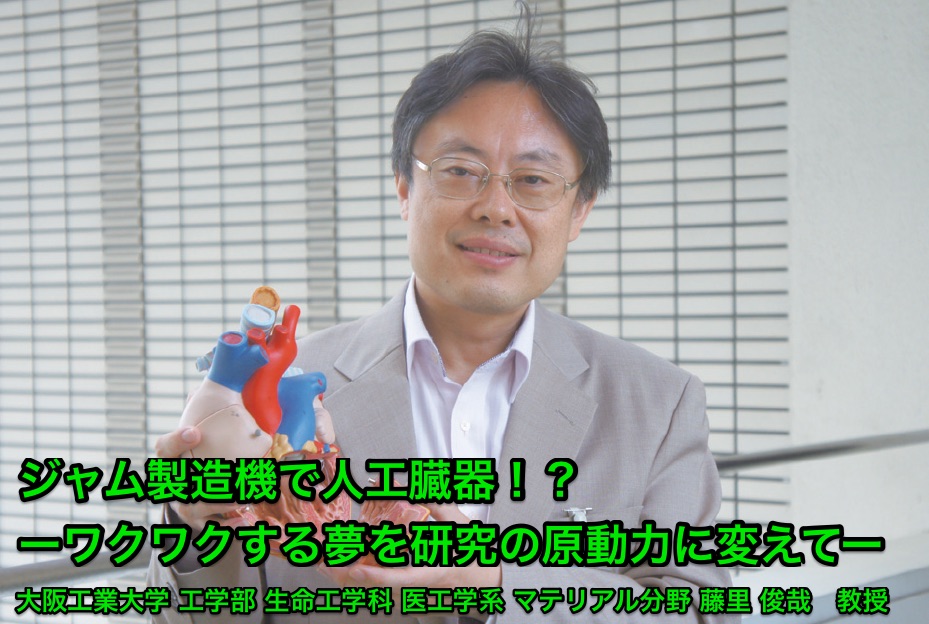
.
The PDF file is in poster format for easy posting! Please download it!
Issue Research Consultation Service News Letter 03 (1445 downloads)
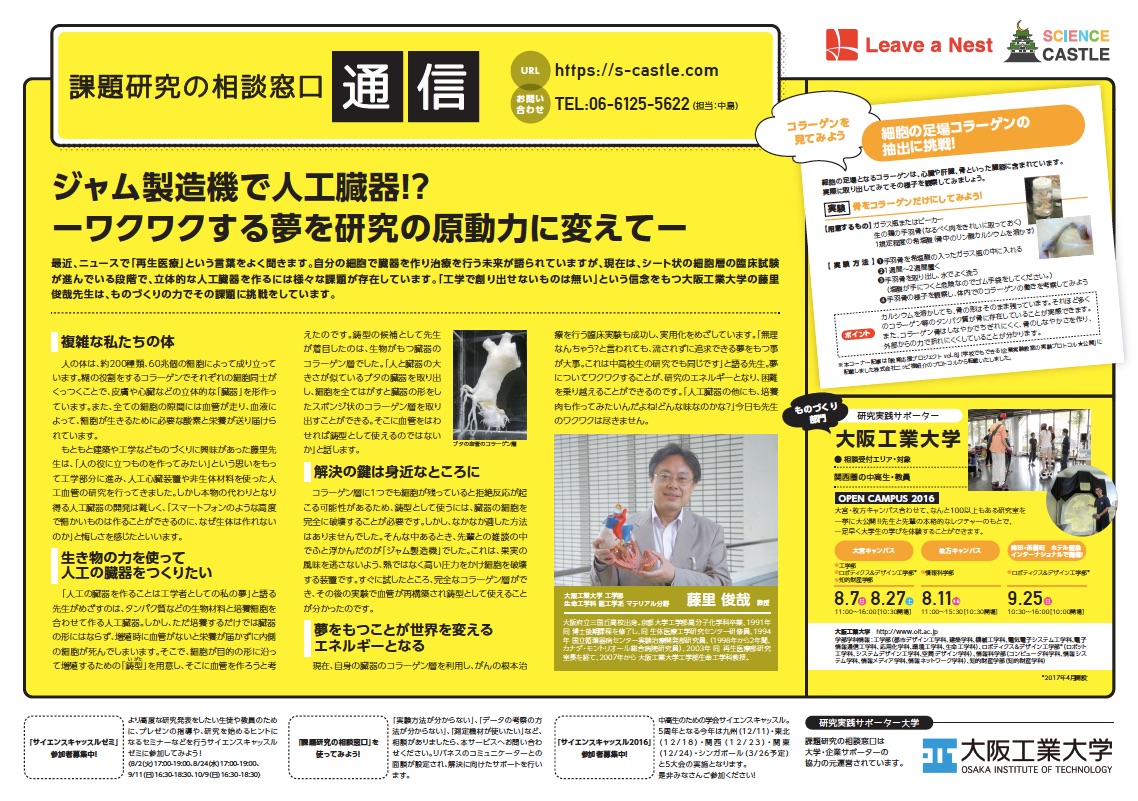
Recently, we often hear the term "regenerative medicine" in the news. The future of creating organs from one's own cells for medical treatment is being talked about, but at present, clinical trials of cell layers in sheet form are in progress, and there are various challenges in creating three-dimensional artificial organs. Dr. Toshiya Fujisato of Osaka Institute of Technology, who believes that "there is nothing that cannot be created through engineering," is taking up the challenge with the power of manufacturing.
Our complex body
The human body is made up of 60 trillion cells of about 200 different types. Each cell is held together by collagen, which acts as glue, to form three-dimensional "organs" such as the skin and heart. In addition, blood vessels run through the spaces between all the cells, and blood delivers the oxygen and nutrients that cells need to live.
I want to create artificial organs using the power of living creatures.
Dr. Fujisato, who had always been interested in manufacturing in fields such as architecture and engineering, entered the engineering field with a desire to "make something useful for people," and conducted research on artificial heart devices and artificial blood vessels made of non-living materials. However, it was difficult to develop artificial organs that could replace the real thing, and he felt frustrated, wondering why he could not make living organisms when he could make sophisticated and detailed products such as smartphones.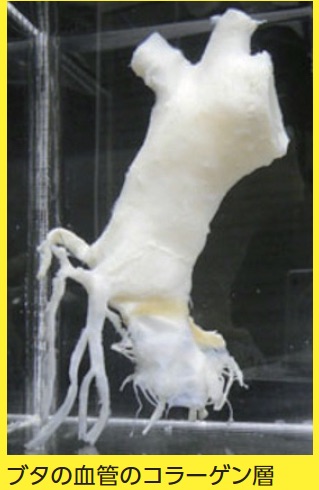
As an engineer, it is my dream to create artificial organs," says the professor, who aims to create artificial organs by combining biological materials such as proteins with cultured cells. However, simply culturing cells does not result in an organ shape. Without blood vessels during proliferation, the inner cells will not receive nutrients and will die. Therefore, the idea was to prepare a "template" for cells to proliferate in accordance with the desired shape and to create blood vessels in it. As a candidate for the template, he focused on the collagen layer of the organs of living organisms. He said, "If you take a pig organ, which is similar in size to a human organ, and peel off all the cells, you can remove a spongy collagen layer in the shape of an organ. If we can attach blood vessels to this layer, we can use it as a template," he says.
The key to the solution is close at hand.
Since rejection can occur if even one cell remains in the collagen layer, it is necessary to completely destroy the cells of the organ in order to use it as a template. However, there was no suitable method. Then one day, during a chat with a senior colleague, the idea of a "jam-making machine" suddenly occurred to me. This is a device that destroys the cells by applying high pressure instead of heat so that the flavor of the fruit is preserved. I immediately tried it and found that a perfect layer of collagen was formed, and subsequent experiments showed that blood vessels could be reconstructed and used as a template.
Having a dream is the energy to change the world.
Currently, he is aiming for practical application of the collagen layer of his own organs in a successful clinical trial for the fundamental treatment of cancer. It is important to have a dream that you can pursue without being carried away, even if people say, "Isn't it impossible? It is important to have a dream that you can pursue without being carried away, even if you are told that it is impossible. The same is true for research conducted by junior and senior high school students," says the professor. Being excited about your dream will give you energy for your research and help you overcome difficulties. I would like to make artificial organs and cultured meat, too! I wonder what it would taste like?" Today, too, the doctor's excitement is endless.
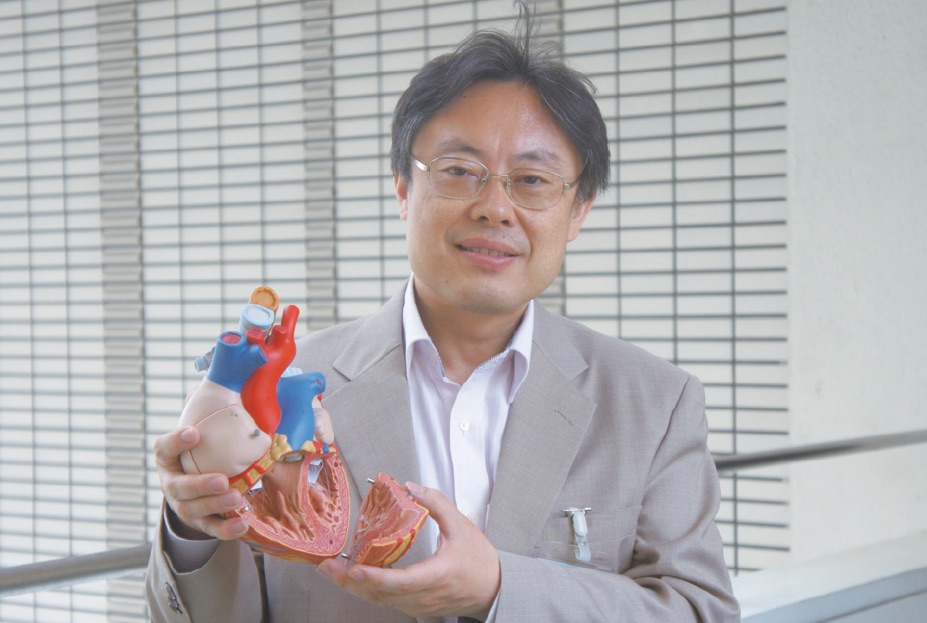 |
| <The teacher we interviewed Osaka Institute of Technology, Faculty of Engineering, Department of Biotechnology, Biomedical Engineering, Materials Science Toshiya Fujisato Professor Graduated from Mikunioka High School in Osaka. After graduating from the Department of Polymer Chemistry, Faculty of Engineering, Kyoto University, and completing the doctoral course at the same university in 1991, he worked as a trainee at the Biomedical Engineering Research Center, National Cardiovascular Center in 1994, as a researcher at the Department of Experimental Therapy Development, National Cardiovascular Center, Montreal, Canada, for two years from 1998, and as a research fellow at the Regenerative Medicine Department at the same center in 2003, Since 2007, Professor, Department of Biotechnology, Faculty of Engineering, Osaka Institute of Technology. |
Let's try it! Let's take out the "collagen layer", the scaffold of cells
| Experiment! Let's make the bones only collagen! Collagen, the scaffold for cells, is found in organs such as the heart, liver, and bones. Let's actually take it out and observe how it looks. Experiment: Let's take out bones with only collagen! ■What to prepare Glass bottle or beaker Raw chicken wing bones (remove as much of the meat as cleanly as possible) Dilute hydrochloric acid of about 1 provision (dissolves calcium phosphate in bone) ■Experimental Methods (1) Place the wing bones in a glass jar containing dilute hydrochloric acid. (2) Leave for 1 to 2 weeks (iii) Remove wing bones and wash well with water. (Wear rubber gloves as hydrochloric acid can be dangerous on hands.) (4) Let's observe the wing bones and consider the function of collagen in the body. |
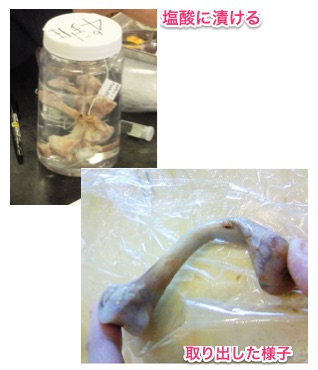 <Points <PointsEven when calcium is dissolved, the bone remains intact. This is how much collagen and other proteins are present in bone. Also, we can see that collagen bones are supple and tear-resistant, creating bone suppleness and making them less likely to be broken by external forces. *This corner article was published in "Education Support Project vol.8" "You can do it at school too! The article is reprinted from the protocol introduced by Nippi Corporation, as described in "Experiment Protocols for Corporate Experimental Classrooms *Open to the Public" in "Education Support Project vol. 8. |
| Research Practice Partner Universities Manufacturing DivisionOsaka Institute of Technology |
| Teachers who have registered as "Education Support Teachers" will receive the latest Science Bridge News every Tuesday as a PDF file edited into an easy-to-use wall newspaper format for use in schools. For more details, please click here ⇒.Science Bridge News for School |
.
The PDF file is in poster format for easy posting! Please download it!
Issue Research Consultation Service News Letter 03 (1445 downloads)

